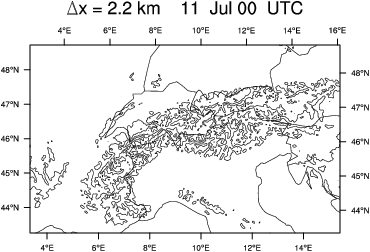Towards Kilometer-Scale Climate Modeling

Project led by: Wolfgang Langhans (IAC, ETHZ)
Lead scientists and supervision: Christoph Schär (IAC, ETHZ) and Mathias Rotach (MeteoSwiss)
Contributing scientists: Christof Appenzeller (MeteoSwiss), Huw Davies (IAC, ETHZ), Philippe Steiner (MeteoSwiss)
Kilometer-scale simulation of convective summertime precipitation over the Alps: Coloured contours show cloud water content and gray contours indicate accumulated precipitation (Click to run animation)
Kilometer-scale simulation of convective summertime precipitation over the Alps: Coloured contours show cloud water content and gray contours indicate accumulated precipitation (Click to run animation).
Atmospheric multiscale interactions at continental to regional scales are of a tremendous complexity and associated with a wide variety of fascinating processes and flow features. The interactions of these processes imply both downscale and upscale cascades of energy. The downscale cascade determines the regional climate in response to large-scale conditions. The upscale cascade encapsulates the aggregated effect of small-scale physical and dynamical processes onto the large-scale climate and thus strongly influences the mean large-scale structure of the atmosphere as well as the frequency of atmospheric circulation types. A rigorous approach to this problem thus requires an appropriate representation of both the downscale and upscale energy cascades in climate models. Due to computational constraints, current global and regional climate models (GCMs and RCMs) operate at grid spacings of 20-300 km. Many important processes can thus not explicitly be resolved and are parameterized instead. Although climate model parameterizations are sophisticated tools based on physical principles, they imply important limitations. Specific difficulties are well known for land-surface processes, moist convection, or turbulence and boundary layer processes over complex topography. These difficulties feed back with the upscale cascade to the whole climate system. Indeed, much of the uncertainty about the sensitivity of the climate system with respect to greenhouse gas forcing is known to be associated with the treatment of moist convection and clouds.
The goal of the present project is thus to replace parameterizations of moist convection in RCMs by an explicit representation, and to refine other parameterizations using a higher spatial resolution of at least ~2 km. We will employ an updated version of the COSMO/CCLM and the focus will be put on moist convection over Alpine orography. A special attention will be given to the horizontal resolution requirements for cloud-resolving simulations at this scale and the representation of turbulent processes in the model. The impact of diurnal mountain circulations on summer-time convection will be also examined.
For additional information, please contact .
Further reading:
DownloadPhD project “Towards kilometer-scale climate modeling” (PDF, 1.3 MB)vertical_align_bottom C2SM newsletter 5 (March 2011), on page 4.
